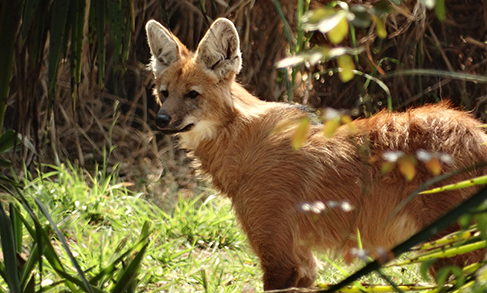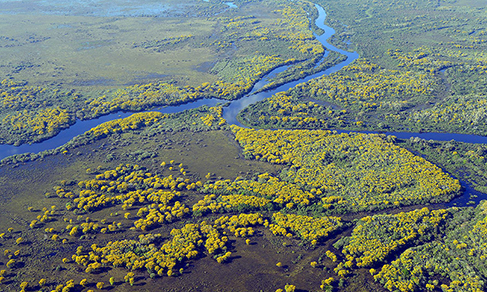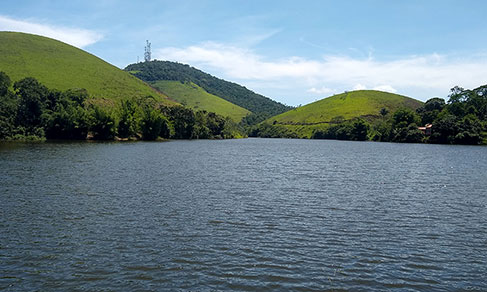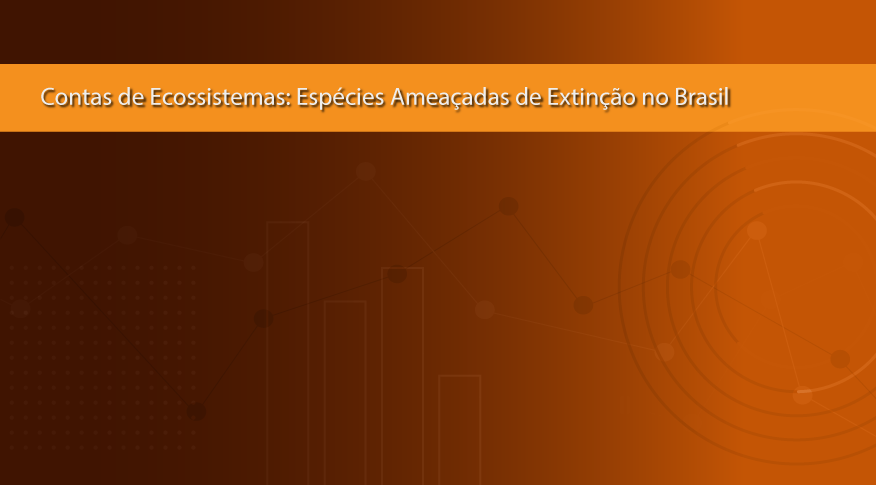Nossos serviços estão apresentando instabilidade no momento. Algumas informações podem não estar disponíveis.
Environmental-Economic Accounting
Description
The Environmental-Economic Accounting is a system of measurement and analysis, represented by a set of tables, which describes the interaction between the environment and the economy in order to give support to planning and decision making for public and business policies.
The methodology of economic and environmental accounting has been established by the United Nations through the System of Environmental-Economic Accounting - SEEA, in order to integrating economic, environmental and social data into a single statistical structure, considering also the characteristics of the country with regard to environmental, social and economic particularities and the availability of data. SEEA has eight thematic areas, including specific natural resources, such as water and energy, in addition to Ecosystem Accounting, among others. The proposed methodology for specific resource accounts is based on a central framework that accounts for the natural resources involved in the production of goods and services, establishing a relationship between the natural resources used and the income generated by different economic activities. In Brazil, the series of information on Environmental-Economic Accounting - CEA, results from a partnership between the IBGE and the National Water Agency - ANA. It began with the disclosure of results on the Environmental-Economic Accounting for Water - CEAA, covering the period from 2013 to 2015, based on the methodological recommendations in a specific manual for water: System of Environmental-Economic Accounting for Water, SEEA-Water. Ecosystem accounting, in turn, is based on the methodological recommendations contained in a specific manual: System of Environmental-Economic Accounting 2012: Experimental Ecosystem Accounting, SEEA-EEA, given the need to cross georeferenced spatial data. This methodology is being consolidated and tested by the United Nations, and the study is still called Experimental Ecosystem Accounting. The IBGE started the methodological tests for ecosystem accounting in 2017, from its participation in the Natural Capital Accounting and Valuation of Ecosystem Services (Ncaves) project - a United Nations global project, financed by the European Union which includes five countries (South Africa, Brazil, China, India and Mexico). The first results of the Ecosystem Accounting include Land Use in Brazilian Biomes, covering the period from 2000 to 2018, and the Endangered Species in Brazil, whose reference is 2014.
Currently, the accounts for water, energy, forests (wood and non-wood resources), biodiversity, ecosystem extent (ET) and ecosystem condition (EC) are being developed, tested and planned by the IBGE in partnership with specialized institutions. The geographic scope of these studies is national, with results published for different territorial sets.
About the publication - 2000-2020 Physical accounting - Brazil
The effects of economic activities on the environment has been a concern in the last decades. In spite of the comprehensive scope of the summary economic indicators produced at the international level, the debate now is about the benefits obtained from nature, from which the economic activities and human well-being depend on, are not being properly measured with the methodologies consolidated ever since. These discussions resulted in the System of environmental-economic accounting 2012: central framework manual, SEEA-CF, of the United Nations Statistics Division (UNSD), which aims at complementing the Systems of National Accounts developed by the countries, by introducing accounting principles to the environmental information, so as to allow a combined analysis of these elements in a single structure.
As part of its program of environmental-economic accounting, the IBGE offers, in this study, a reflection on the physical accounting of the Environmental-Economic Accounts for Land in Brazil, considering the dynamics of the occupation of the territory and its changes along the period between 2000 and 2020.
The publication is organized into three sections. The first one, Technical notes, discusses some referentials from which this reflection is based, contextualizes the investigation of land accounting in other countries, describes the directives that guided the development of this study in Brazil and details its major methodological aspects. The second section, Analysis of the results, discusses the matrix of changes in land use and cover in Brazil, reviews the conversions considered relevant in this accounting period, at regional scale, highlighting the occupation patterns, both the recent ones and some historical ones. In order to complement such reflections, it outlines the major land characteristics of the agricultural establishments in Brazil, based on a cross analysis of the IBGE´s statistics, providing a transversal view of geospatial and economic aspects of the agricultural dynamics. The third section, Final considerations, summarizes the major observations on the occupation conversions and land use in Brazil resulting from this study, as well as it assesses aspects of the scenario glimpsed in the scope of the environmental accounting. In the end of the publication, a glossary gathers the concepts considered key to understand the results.
It is expected that this study, coupled with other studies developed in the scope of the System of Environmental-Economic Accounts (SEEA), also available on the IBGE portal, contributes to a more comprehensive knowledge of the Brazilian reality, as well as to the formulation and execution of public policies towards an environmentally-sustainable and economically-efficient management of the Brazilian environmental assets.
More on the product - 2000-2020 Physical accounting - Brazil
Publications
- Environmental-Economic Accounts for Land: Physical accountability: Brazil 2000-2020 (book)
- Environmental-Economic Accounts for Land: Physical accountability: Brazil 2000-2020 (folder) - updated on October 7, 2022 at 7 PM
Tables of SIDRA system
Environmental-Economic Accounts for Land: Physical Accountability
Maps
Map 1 - Land use and cover - Brazil - 2000 (PDF)
Map 2 - Land use and cover - Brazil - 2020 (PDF)
Map 3 - Distribution of areas of changes in land use and cover - Brazil - 2000-2020 (PDF)
Map 4 - Distribution of Pasture with management - Brazil - 2000 (PDF)
Map 5 - Distribution of Pasture with management - Brazil - 2020 (PDF)
Map 6 - Conversions to Pasture with management in the Federation Units - 2000-2020 (PDF)
Map 7 - Conversions from Pasture with management in the Federation Units - 2000-2020 (PDF)
Map 8 - Distribution of Agricultural area - Brazil - 2000 (PDF)
Map 9 - Distribution of Agricultural area - Brazil - 2020 (PDF)
Map 10 - Conversions to Agricultural area in the Federation Units - 2000-2020 (PDF)
Map 11 - Conversions from Agricultural area in the Federation Units - 2000-2020 (PDF)
Map 12 - Distribution of Silviculture - Brazil - 2000 (PDF)
Map 13 - Distribution of Silviculture - Brazil 2020 (PDF)
Map 14 - Conversions to Silviculture in the Federation Units - 2000-2020 (PDF)
Map 15 - Conversions from Silviculture in the Federation Units - 2000-2020 (PDF)
Tables
Table 1 - Physical stocks of asset land, according to the classes of land use and cover - Brazil - 2000-2020 (xlsx)
Table 2 - Matrix of changes in land use and cover - Brazil - 2000-2020 (xlsx) - (updated on October 7, 2022 at 12 PM)
Table 3 - Coefficients of correlation between the growth rates of stocks of Agricultural areas and planted areas of the major crops of temporary farming, according to the Federation Units - 2000-2020 (xlsx) - (updated on October 7, 2022 at 12 PM)
Table 4 - Coefficients of correlation between the growth rate of stocks of land classified as Pasture with management and growth rate of the number of cattle head, according to the Federation Units - 2000-2020 (xlsx)
Publications - 2000-2020 Physical accounting - Brazil
Learn more - 2000-2020 Physical accounting - Brazil
News and Releases
Environmental-Economic Accounting for Water: Brazil
In 2020, Brazil consumes 6.2 liters of water for each R$1 generated by the Economy
In 2020, 6.2 liters of water were consumed for each real of gross value added (GVA) generated by the...
02/06/2023
Ecosystem Accounting
IBGE updates statistics on threatened species in Brazilian biomes
The IBGE released today (24) the updated data on threatened species for year 2022. This set of information...
24/05/2023
Ecosystem AccountingEnvironmental-Economic Accounting for Land
Between 2000 and 2020, agricultural area grew 230 thousand km², natural vegetation reduced 513 thousand km² in Brazil
The IBGE released today (7) the Environmental-Economic Accounting for Land: Physical Accountability,...
07/10/2022
Ecosystem Accounting
In partnership with the UN, IBGE releases integrated analysis of Ecosystem Accounts
The IBGE releases today (20) “Ecosystem Accounts: results of the NCAVES project in Brazil ”, which compiles...
20/05/2022
Environmental-Economic Accounts for Energy: products from biomass
In 2018, Brazil generated R$84 billion in energy products from biomass
In 2018, the national production of natural energy inputs from biomass was 91.3 million tonnes of oil...
09/12/2021
Environmental-Economic Accounts for Energy: products from biomass
Biomass products represented 9% of electricity in Brazil in 2018
In 2018, the production of electricity from energy products from biomass was of 54.4 thousand gigawatt-hour...
09/12/2021
Ecosystem Accounting
Experimental study estimates value of water bodies during abstraction, treatment and distribution of water
The IBGE has released today (28) Ecosystem Accounting: Value of the Ecosystem Service of Blue Water Provisioning...
28/04/2021
Ecosystem Accounting
Experimental study analyzes amount and value of non-wood forest products per biome
The IBGE has released today (15) the Ecosystem Accounts: Non-Wood Forest Products, experimental statistics...
15/04/2021
Environmental-Economic Accounting for Water: Brazil
Experimental study evaluates water conditions in Brazilian biomes
The IBGE has released today (15) Ecosystem Accounting: Condition of Water Bodies, experimental statistics...
15/04/2021
Ecosystem Accounting
In 2014, Atlantic Forest/Mata Atlântica was the biome with the highest number of species threatened with extinction
The survey “Ecosystem Accounting: Species Threatened with Extinction in Brazil”, which the IBGE releases...
05/11/2020
Errata
Correction in the publication “Ecosystem Accounting: Valuation of the ecosystem service of blue water provision 2013-2017”
Published date: 04/05/2021
Description:
Two typing errors were identified on page 26, in the title for Graph 7 and in the first paragraph, in the unit of measurement adopted in both of the cases.Actions: The file has been replaced.
Amendment in “Ecosystem accounts: land use in Brazilian biomes 2000-2018” publication
Published date: 16/10/2020
Description:
An error was pinpointed by the IBGE in the percentage data of the main conversion of land use in the Pantanal Biome. Due to a typing error, the percentage reported in the publication does not involve that in the survey´s databases.Actions: The text in the publication was changed to report the correct percentage.
Error in the release date of the publication "Ecosystem Accounting: Species Threatened with Extinction in Brazil 2014"
Published date: 02/10/2020
Description:
The IBGE identified an error for the non-compliance with the release date of the publication Ecosystem Accounts: Species Threatened with Extinction in Brazil 2014, expected to be released in October according to the calendar of geoscientific products available on the portal. Due to the COVID-19 pandemic, the release was postponed until November 05, 2020.Actions: The release calendar was changed.
Error in the release date of the publication "Ecosystem Accounting: Biodiversity and Species Threatened with Extinction, version 2014"
Published date: 28/09/2020
Description:
Error, identified by the IBGE, of non-compliance with the release date of the publication Ecosystem Accounting: Biodiversity and Biodiversity and Species Threatened with Extinction, version 2014, scheduled for September in the geoscientific products calendar on the IBGE web site. Due to the COVID-19 pandemic, its disclosure was postponed until October 16, 2020.Actions: The release date was rescheduled.
Links
Our websites:
SIDRA | Statistical Tables Database
Methodological manuals:
Manual of the System of Environmental-Economic Accoutning- Central Framework (UN)
Manual of the System of Environmental-Economic Accounting - Experimental Ecosystem Accounting (UN)
Other publications:
Ecosystems Accounts: Results of NCAVES Project in Brazil
Water Use in Rainfed Agriculture
International classification of ecosystems in Brazil
Other links:
Natural Capital Accounting and Valuation of Ecosystem Services (UN)













